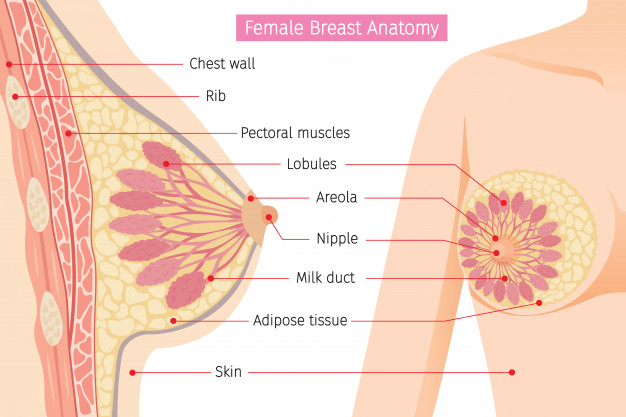Breasts are both part of your reproductive anatomy and sexual anatomy. They’re considered essential reproductive parts because moms can use their breasts to feed their infants.
When it comes to sexual anatomy, breasts are often sexually sensitive and considered an erogenous zone, and part of a lot of people’s sexuality. For some, they consider their breasts as a part of their gender and sexual identity. Breasts can even be a common source of body image insecurities.
Your breasts are not sexual for most days of your life. In fact, their sexual function is only secondary while the primary function of breasts is for breastfeeding, even if you don’t use them for that purpose.
What makes a breast friend?
For those assigned female at birth, breasts are primarily composed of four different things: connective tissue, fat, milk glands (known as lobules), and milk ducts.
Technically, those assigned male at birth have breasts, too. However, it’s the hormonal differences (mostly estrogen levels) between male and female that make male breasts not as prominent as those of female breasts. Male breasts also don’t have the capacity to breastfeed.

The breasts are located on top of the rib cage, over the chest or pectoral muscles, and connected to the body with the help of ligaments.
The breast itself doesn’t have muscles; only underneath the breasts, which are called the pectoral muscles. It’s the fat and glands of the breast that give its shape and size.
The mammary glands and milk ducts
The mammary glands (lobules) are located in the pockets of fat between the ligaments of the breast, which also lead to the milk ducts.
Each breast has around 15 to 20 milk ducts behind the areola, which connect the mammary gland to the nipple. These milk ducts are responsible for producing milk for the infant during and after pregnancy.
The areola and Montgomery glands
The dark area at the center of the breast and surrounding the nipple is called the areola. It’s often believed that the size of the areola should “match” the size of the breasts. However, breast size doesn’t really dictate how big the areolas will be. Big breasts can have small areolas, and small breasts can have big areolas.
If you take a closer look at your areolas and see little bumps, those are called Montgomery glands. Sometimes they can also appear on the nipple itself. They’re normal and don’t necessarily need to be removed.
The nipples
For most people, their nipples slightly protrude (and become more prominent when cold or aroused). Some may have inverted nipples, or also known as retracted nipples.
What causes inverted nipples?
Inverted nipples are flat or pointed inwards, rather than pointing out. You can have it on just one breast or both. It shouldn’t cause any worry if you were born this way. But if you noticed that it only happened recently or later in life, better consult your doctor to find out if it’s a sign of a medical problem.
The Shape
Your breast may not look like the breasts on the image above, that’s because breasts come in different shapes and sizes. Some may have round breasts, while others may have breasts that look more oblong or triangular. Every person’s breast friends may even hang out in different ways! Regardless of the size, breasts can be perky or “droop” down.
There’s no “perfect” breast shape and size that is necessarily more functional or better than another. Just as how each person has a unique face, our breasts also differ from everyone else’s.
Breasts may or may not be proportional with the rest of the body, or be in harmony with your body type. Large people can have small breasts, and small people sometimes have large breasts.
Breasts can also be asymmetrical, which means that they don’t look identical or don’t have the same size and shape. Most women have asymmetrical breasts, and this is totally normal.
The Size
Genetics primarily determines the size of your breasts. Your physical characteristics such as breast volume and bone structure depends on your family’s genes.
Breast size will not increase with the use of supplements of cream, even if you take oral contraceptive pills. Some claim that their breast size increased when they started taking pills, but this is only caused by water retention, which will subside immediately.
Rumor has it that drinking soy milk or milk will make breasts bigger. These drinks contain estrogen-like substances, which mimic the effects of estrogen to the body. There is no strong evidence that proves whether soy milk and dairy products can increase breast size.
No amount of lotions, creams, supplements, massaging, or working out your chest muscles will make your breasts bigger. Your breasts size doesn’t determine your worth, ladies! You are perfect as you are.
What can affect breast size
Age. How your breasts look like when you are a teenager will likely be different as you get older. It may get bigger or smaller and will probably sag.
Weight. Cup size and torso circumference can change when you gain or lose weight. Your bra size may go up or down if you gain or lose a few pounds.
Hormones. Breasts tend to be temporarily bigger and more tender before menstrual bleeding. That’s because estrogen and progesterone enlarge the breast ducts and milk glands.
Hormones during pregnancy also affect breast size. Estrogen, progesterone, and prolactin stimulate breast milk production. Breasts may continually grow bigger as a pregnancy progresses to prepare for lactation.
Once you hit menopause, estrogen levels go down. This may cause breasts to lose elasticity and become smaller.
Sources:
https://www.scarleteen.com/article/advice/abreast_the_basics_of_boobies
https://www.healthline.com/health/can-you-increase-your-breast-size-by-eating-certain-foods
https://www.healthline.com/health/montgomerys-tubercles



